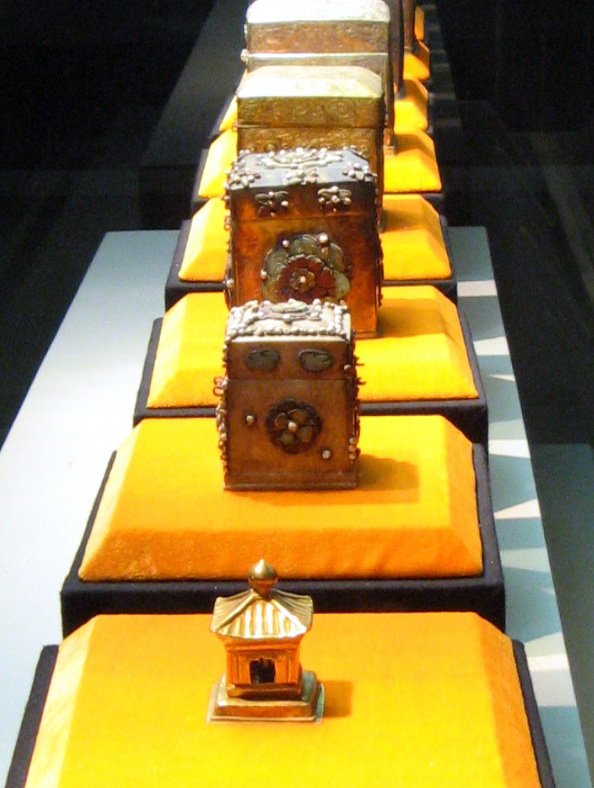Chinese Boxes on:
[Wikipedia]
[Google]
[Amazon]
 Chinese boxes () are a set of boxes of graduated size, each fitting inside the next larger box.
A traditional style in Chinese design, nested boxes have proved a popular packaging option in the West for novelty or display reasons.
Chinese nested boxes have inspired similar forms of packaging around the world, but also have found use as a figurative description, providing an illustrative example to demonstrate situations of conceptually nested or recursive arrangements.
In literature, a Chinese box structure refers to a
Chinese boxes () are a set of boxes of graduated size, each fitting inside the next larger box.
A traditional style in Chinese design, nested boxes have proved a popular packaging option in the West for novelty or display reasons.
Chinese nested boxes have inspired similar forms of packaging around the world, but also have found use as a figurative description, providing an illustrative example to demonstrate situations of conceptually nested or recursive arrangements.
In literature, a Chinese box structure refers to a
 Chinese boxes () are a set of boxes of graduated size, each fitting inside the next larger box.
A traditional style in Chinese design, nested boxes have proved a popular packaging option in the West for novelty or display reasons.
Chinese nested boxes have inspired similar forms of packaging around the world, but also have found use as a figurative description, providing an illustrative example to demonstrate situations of conceptually nested or recursive arrangements.
In literature, a Chinese box structure refers to a
Chinese boxes () are a set of boxes of graduated size, each fitting inside the next larger box.
A traditional style in Chinese design, nested boxes have proved a popular packaging option in the West for novelty or display reasons.
Chinese nested boxes have inspired similar forms of packaging around the world, but also have found use as a figurative description, providing an illustrative example to demonstrate situations of conceptually nested or recursive arrangements.
In literature, a Chinese box structure refers to a frame narrative
A frame is often a structural system that supports other components of a physical construction and/or steel frame that limits the construction's extent.
Frame and FRAME may also refer to:
Physical objects
In building construction
* Framing (c ...
, where a novel or drama is told in the form of a narrative inside a narrative (and so on), giving views from different perspectives. Examples include Plato
Plato ( ; grc-gre, Πλάτων ; 428/427 or 424/423 – 348/347 BC) was a Greek philosopher born in Athens during the Classical period in Ancient Greece. He founded the Platonist school of thought and the Academy, the first institutio ...
's dialogue '' Symposion'', Mary Shelley
Mary Wollstonecraft Shelley (; ; 30 August 1797 – 1 February 1851) was an English novelist who wrote the Gothic novel '' Frankenstein; or, The Modern Prometheus'' (1818), which is considered an early example of science fiction. She also ...
's 1818 novel ''Frankenstein
''Frankenstein; or, The Modern Prometheus'' is an 1818 novel written by English author Mary Shelley. ''Frankenstein'' tells the story of Victor Frankenstein, a young scientist who creates a sapient creature in an unorthodox scientific exp ...
'', Jostein Gaarder
Jostein Gaarder (; born 8 August 1952) is a Norwegian intellectual and author of several novels, short stories, and children's books. Gaarder often writes from the perspective of children, exploring their sense of wonder about the world. He often ...
's '' The Solitaire Mystery'', Emily Brontë
Emily Jane Brontë (, commonly ; 30 July 1818 – 19 December 1848) was an English novelist and poet who is best known for her only novel, ''Wuthering Heights'', now considered a classic of English literature. She also published a book of poet ...
's ''Wuthering Heights
''Wuthering Heights'' is an 1847 novel by Emily Brontë, initially published under her pen name Ellis Bell. It concerns two families of the landed gentry living on the West Yorkshire moors, the Earnshaws and the Lintons, and their turbulent r ...
'', and Joseph Conrad
Joseph Conrad (born Józef Teodor Konrad Korzeniowski, ; 3 December 1857 – 3 August 1924) was a Polish-British novelist and short story writer. He is regarded as one of the greatest writers in the English language; though he did not sp ...
's ''Heart of Darkness
''Heart of Darkness'' (1899) is a novella by Polish-English novelist Joseph Conrad in which the sailor Charles Marlow tells his listeners the story of his assignment as steamer captain for a Belgian company in the African interior. The novel ...
''.
See also
*Recursion
Recursion (adjective: ''recursive'') occurs when a thing is defined in terms of itself or of its type. Recursion is used in a variety of disciplines ranging from linguistics to logic. The most common application of recursion is in mathematic ...
*Mise en abyme
In Western art history, ''mise en abyme'' (; also ''mise en abîme'') is a formal technique of placing a copy of an image within itself, often in a way that suggests an infinitely recurring sequence. In film theory and literary theory, it refers ...
* Matryoshka doll
References
External links
Containers Chinese inventions Nested containers {{design-stub